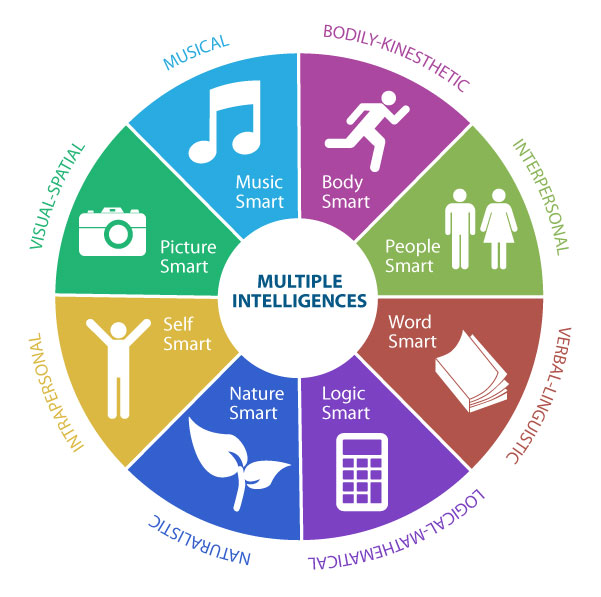Lesson 1.6: Howard Gardner’s Multiple Intelligences Theory
The last learning theory previewed here is called Gardner’s Multiple Intelligences Theory, of which there are currently nine so-called intelligences, listed as follows. (Note: number nine is pretty new on Professor Gardner’s evolving list and is yet to be included in most representative graphics, such as the one below.)
- musical-rhythmic and harmonic
- visual-spatial
- verbal-linguistic
- logical-mathematical
- bodily-kinesthetic
- interpersonal
- intrapersonal
- naturalist
- existential.

When I began teaching effective learning classes, there were still just the original eight intelligences. According to the article, Gardner may soon add even more, including “teaching-pedagogical intelligence… humor, cooking and sexual intelligence.” In Gardner’s view, human beings are indeed multi-talented and multi-intelligent.
To help you remember the various learning abilities cited in this theory that are available to us to comprehend and interact with the environments in which we live, study, and work, complete the exercises below.
UNIT 1, EXERCISE 6.1
- Read the article linked above.
- Create a list of these intelligences, but define them in your own words.
- For each intelligence and definition, also create a picture as a mnemonic device. You may wish to create a three-column chart on which to organize the information, for example:
INTELLIGENCE DEFINITION PICTURE/SYMBOL
UNIT 1, EXERCISE 6.2
PART A
Individually, in a team, or in a study group, list as many “intelligences” you can discern that would be used to accomplish the following tasks:
- Shopping for groceries:
- Changing the oil in the car:
- Planning a garden:
- Acing a math test:
- Writing a report on the human digestive system:
- Running a 10k fundraising event:
- Comforting a friend who just lost a loved one:
- Organizing a softball game:
- Collecting samples of music from Latin American countries:
- Hosting a religious study:
- Designing a brochure of information for new college students:
- Performing a scene with your study group from a Shakespearean play:
PART B
Choose 5 of the nine intelligences, and design an activity for each one. Challenge: see if you can design just 1 activity that would incorporate all 5!

